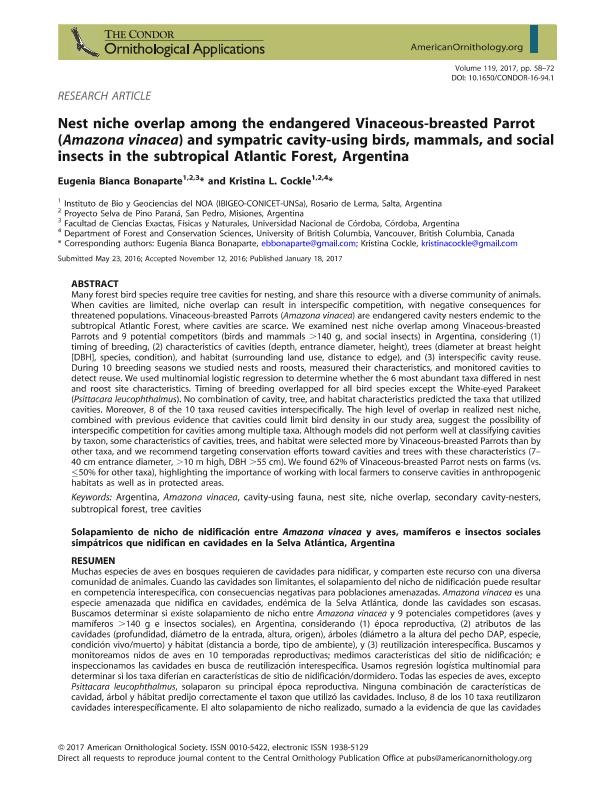Mostrar el registro sencillo del ítem
dc.contributor.author
Bonaparte, Eugenia Bianca

dc.contributor.author
Cockle, Kristina Louise

dc.date.available
2018-06-21T21:02:58Z
dc.date.issued
2017-01-18
dc.identifier.citation
Bonaparte, Eugenia Bianca; Cockle, Kristina Louise; Nest niche overlap among the endangered Vinaceous-breasted Parrot (Amazona vinacea) and sympatric cavity-using birds, mammals, and social insects in the subtropical Atlantic Forest, Argentina; Cooper Ornithological Society; The Condor; 119; 1; 18-1-2017; 58-72
dc.identifier.issn
0010-5422
dc.identifier.uri
http://hdl.handle.net/11336/49605
dc.description.abstract
Many forest bird species require tree cavities for nesting, and share this resource with a diverse community of animals. When cavities are limited, niche overlap can result in interspecific competition, with negative consequences for threatened populations. Vinaceous-breasted Parrots (Amazona vinacea) are endangered cavity nesters endemic to the subtropical Atlantic Forest, where cavities are scarce. We examined nest niche overlap among Vinaceous-breasted Parrots and 9 potential competitors (birds and mammals >140 g, and social insects) in Argentina, considering (1) timing of breeding, (2) characteristics of cavities (depth, entrance diameter, height), trees (diameter at breast height DBH, species, condition), and habitat (surrounding land use, distance to edge), and (3) interspecific cavity reuse. During 10 breeding seasons we studied nests and roosts, measured their characteristics, and monitored cavities to detect reuse. We used multinomial logistic regression to determine whether the 6 most abundant taxa differed in nest and roost site characteristics. Timing of breeding overlapped for all bird species except the White-eyed Parakeet (Psittacara leucophthalmus). No combination of cavity, tree, and habitat characteristics predicted the taxa that utilized cavities. Moreover, 8 of the 10 taxa reused cavities interspecifically. The high level of overlap in realized nest niche, combined with previous evidence that cavities could limit bird density in our study area, suggest the possibility of interspecific competition for cavities among multiple taxa. Although models did not perform well at classifying cavities by taxon, some characteristics of cavities, trees, and habitat were selected more by Vinaceous-breasted Parrots than by other taxa, and we recommend targeting conservation efforts toward cavities and trees with these characteristics (7-40 cm entrance diameter, >10 m high, DBH >55 cm). We found 62% of Vinaceous-breasted Parrot nests on farms (vs. ≤50% for other taxa), highlighting the importance of working with local farmers to conserve cavities in anthropogenic habitats as well as in protected areas.
dc.format
application/pdf
dc.language.iso
eng
dc.publisher
Cooper Ornithological Society

dc.rights
info:eu-repo/semantics/openAccess
dc.rights.uri
https://creativecommons.org/licenses/by-nc-sa/2.5/ar/
dc.subject
Amazona Vinacea
dc.subject
Argentina
dc.subject
Cavity-Using Fauna
dc.subject
Nest Site
dc.subject
Niche Overlap
dc.subject
Secondary Cavity-Nesters
dc.subject
Subtropical Forest
dc.subject
Tree Cavities
dc.subject.classification
Otras Ciencias Biológicas

dc.subject.classification
Ciencias Biológicas

dc.subject.classification
CIENCIAS NATURALES Y EXACTAS

dc.title
Nest niche overlap among the endangered Vinaceous-breasted Parrot (Amazona vinacea) and sympatric cavity-using birds, mammals, and social insects in the subtropical Atlantic Forest, Argentina
dc.type
info:eu-repo/semantics/article
dc.type
info:ar-repo/semantics/artículo
dc.type
info:eu-repo/semantics/publishedVersion
dc.date.updated
2018-05-23T13:33:01Z
dc.journal.volume
119
dc.journal.number
1
dc.journal.pagination
58-72
dc.journal.pais
Estados Unidos

dc.journal.ciudad
Chicago
dc.description.fil
Fil: Bonaparte, Eugenia Bianca. Consejo Nacional de Investigaciones Científicas y Técnicas. Centro Científico Tecnológico Conicet - Salta. Instituto de Bio y Geociencias del NOA. Universidad Nacional de Salta. Facultad de Ciencias Naturales. Museo de Ciencias Naturales. Instituto de Bio y Geociencias del NOA; Argentina. Universidad Nacional de Córdoba; Argentina
dc.description.fil
Fil: Cockle, Kristina Louise. Consejo Nacional de Investigaciones Científicas y Técnicas. Centro Científico Tecnológico Conicet - Salta. Instituto de Bio y Geociencias del NOA. Universidad Nacional de Salta. Facultad de Ciencias Naturales. Museo de Ciencias Naturales. Instituto de Bio y Geociencias del NOA; Argentina. University of British Columbia; Canadá
dc.journal.title
The Condor

dc.relation.alternativeid
info:eu-repo/semantics/altIdentifier/url/http://www.bioone.org/doi/pdf/10.1650/CONDOR-16-94.1
dc.relation.alternativeid
info:eu-repo/semantics/altIdentifier/doi/http://dx.doi.org/10.1650/CONDOR-16-94.1
Archivos asociados
